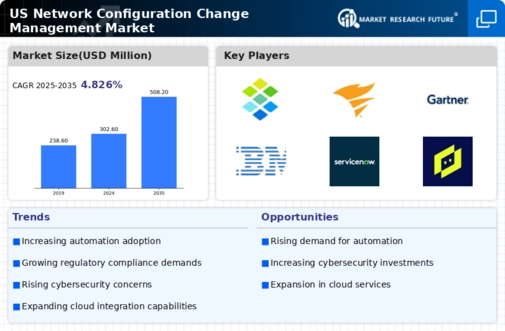Growth of Cloud Computing
The rapid adoption of cloud computing services is reshaping the network configuration-change-management market. As organizations migrate to cloud environments, they require effective management of network configurations to ensure optimal performance and security. The cloud services market in the US is expected to exceed $500 billion by 2025, which directly correlates with the demand for configuration management solutions. This growth necessitates tools that can seamlessly manage configurations across hybrid and multi-cloud environments. Consequently, vendors are focusing on developing solutions that cater to the unique challenges posed by cloud infrastructures, thereby propelling the market forward.
Focus on Operational Efficiency
Organizations are increasingly prioritizing operational efficiency as a means to reduce costs and improve service delivery. In the network configuration-change-management market, this focus is leading to the adoption of automation and streamlined processes. Companies are investing in solutions that minimize manual intervention, thereby reducing the likelihood of errors and enhancing productivity. The market is expected to benefit from this trend, as businesses recognize the value of efficient configuration management in maintaining optimal network performance. By leveraging advanced tools, organizations can achieve significant cost savings and improve their overall operational effectiveness, further propelling the growth of the market.
Regulatory Compliance Requirements
The network configuration-change-management market is significantly influenced by the need for compliance with various regulatory frameworks. Organizations are increasingly required to adhere to standards such as PCI DSS, SOX, and NIST, which mandate strict controls over network configurations. Non-compliance can result in hefty fines, making it imperative for businesses to invest in effective configuration management solutions. The market is projected to grow as companies seek tools that facilitate compliance audits and reporting. This trend indicates a shift towards solutions that not only manage configurations but also provide comprehensive compliance features, thereby enhancing the overall value proposition of the market.
Rising Demand for Network Security
The increasing frequency of cyber threats has led to a heightened focus on network security within the network configuration-change-management market. Organizations are investing significantly in solutions that enhance their security posture, with the market projected to reach approximately $2 billion by 2026. This demand is driven by the necessity to protect sensitive data and maintain compliance with regulations such as GDPR and HIPAA. As businesses recognize the importance of secure network configurations, the market is likely to experience robust growth. Furthermore, the integration of advanced security features into configuration management tools is becoming a standard expectation, thereby influencing purchasing decisions and driving innovation in the industry.
Increased Complexity of Network Environments
As organizations expand their IT infrastructures, the complexity of network environments continues to rise. This complexity necessitates sophisticated configuration management solutions to ensure that all components function harmoniously. The network configuration-change-management market is responding to this challenge by offering tools that provide visibility and control over intricate network setups. With the proliferation of IoT devices and remote work arrangements, the demand for effective management solutions is likely to increase. Companies are seeking ways to streamline their operations and reduce the risk of misconfigurations, which can lead to downtime and security vulnerabilities, thus driving growth in the market.






















Leave a Comment